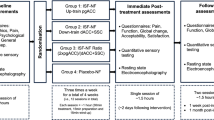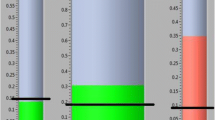Abstract
Purpose
Chronic low back pain (cLBP) affects a quarter of a population during its lifetime. The most severe cases include patients not responding to interventions such as 5-week-long in-hospital multi-disciplinary protocols. This document reports on a pilot study offering an alpha-phase synchronization (APS) brain rehabilitation intervention to a population of n = 16 multi-resistant cLBP patients.
Methods
The intervention consists of 20 sessions of highly controlled electroencephalography (EEG) APS operant conditioning (neurofeedback) paradigm delivered in the form of visual feedback. Visual analogue scale for pain, Dallas, Hamilton, and HAD were measured before, after, at 6-month and 12-month follow-up. Full-scalp EEG data were analyzed to study significant changes in the brain’s electrical activity.
Results
The intervention showed a great and lasting response of most measured clinical scales. The clinical improvement was lasting beyond the 6-month follow-up endpoints. The EEG data confirm that patients did control (intra-session trends) and learned to better control (intersession trends) their APS neuromarker resulting in (nonsignificant) baseline changes in their resting state activity. Last and most significantly, the alpha-phase concentration (APC) neuromarker, specific to phase rather than amplitude, was found to correlate significantly with the reduction in clinical symptoms in a typical dose–response effect.
Conclusion
This first experiment highlights the role of the APC neuromarker in relation to the nucleus accumbens activity and its role on nociception and the chronicity of pain. This study suggests APC rehabilitation could be used clinically for the most severe cases of cLBP. Its excellent safety profile and availability as a home-use intervention makes it a potentially disruptive tool in the context of nonsteroidal anti-inflammatory drugs and opioid abuses.
Graphic abstract
These slides can be retrieved under Electronic Supplementary Material.








Similar content being viewed by others
Change history
01 December 2020
A Correction to this paper has been published: https://doi.org/10.1007/s00586-020-06666-3
References
Apkarian AV, Hashmi JA, Baliki MN (2011) Pain and the brain: specificity and plasticity of the brain in clinical chronic pain. Pain 152(3 Suppl):S49–S64
Balague F, Troussier B, Salminen JJ (1999) Non-specific low back pain in children and adolescents: risk factors. Eur Spine J 8:429–438
Baliki MN, Geha PY, Fields HL, Apkarian AV (2010) Predicting value of pain and analgesia: nucleus accumbens response to noxious stimuli changes in the presence of chronic pain. Neuron 66:149–160
Baptista AF, Fernandes AMBL, Sá KN, Okano AH, Brunoni AR, Lara-Solares A, Iskandar AJ, Guerrero C, Amescua-García C, Kraychete DC et al (2019) Latin American and Caribbean consensus on noninvasive central nervous system neuromodulation for chronic pain management (LAC2-NIN-CP). Pain Rep 4:e692
Barry RJ, Clarke AR, McCarthy R, Selikowitz M, Johnstone SJ, Rushby JA (2004) Age and gender effects in EEG coherence: I. Developmental trends in normal children. Clin Neurophysiol 115:2252–2258
Becerra L, Borsook D (2008) Signal valence in the nucleus accumbens to pain onset and offset. Eur J Pain 12:866–869
Benarroch EE (2016) Involvement of the nucleus accumbens and dopamine system in chronic pain. Neurology 87(16):1720–1726
Bontoux L, Roquelaure Y, Billabert C, Dubus V, Sancho PO, Colin D, Brami L, Moisan S, Fanello S, Penneau-Fontbonne D, Richard I (2004) Étude du devenir à un an de lombalgiques chroniques inclus dans un programme associant reconditionnement à l’effort et action ergonomique. recherche de facteurs prédictifs de retour et de maintien au travail. Annales de réadaptation et de médecine physique 47:563–572
Brena SF, Wolf SL, Chapman SL, Hammonds WD (1980) Chronic back pain: electromyographic, motion and behavioral assessments following sympathetic nerve blocks and placebos. Pain 8:1–10
Bushnell MC, Ceko M, Low LA (2013) Cognitive and emotional control of pain and its disruption in chronic pain. Nat Rev Neurosci 14(7):502–511
Bussalb A, Congedo M, Barthélemy Q, Ojeda D, Acquaviva E, Delorme R, Mayaud L (2019) Clinical and experimental factors influencing the efficacy of neurofeedback in ADHD: a meta-analysis. Front Psychiatry 10:35
Caro XJ, Winter EF (2011) EEG biofeedback treatment improves certain attention and somatic symptoms in fibromyalgia: a pilot study. Appl Psychophysiol Biofeedback 36:193–200
Chang P-C, Pollema-Mays SL, Centeno MV, Procissi D, Contini M, Baria AT, Martina M, Apkarian AV (2014) Role of nucleus accumbens in neuropathic pain: linked multi-scale evidence in the rat transitioning to neuropathic pain. Pain 155:1128–1139
Cohen MX (2014) Analyzing neural time series data: theory and practice. MIT Press, Cambridge
Dolan P, Mannion AF, Adams MA (1995) Fatigue of the erector spinae muscles. A quantitative assessment using “frequency banding” of the surface electromyography signal. Spine 20:149–159
Durup G, Fessard A (1935) I. l’électrencéphalogramme de l’homme. Observations psycho-physiologiques relatives à l’action des stimuli visuels et auditifs. L’année psychologique 36:1–32
Fassier J-B (2011) Prévalence, coûts et enjeux sociétaux de la lombalgie. Revue du rhumatisme 78:S38–S41
Flor H (2014) Role of cortical reorganization in the rehabilitation of chronic pain. In: Replace, repair, restore, relieve—bridging clinical and engineering solutions in neurorehabilitation. Springer, pp 1–2. https://doi.org/10.1007/978-3-319-08072-7_1
Fuchs PN, Peng YB, Boyette-Davis JA, Uhelski ML (2014) The anterior cingulate cortex and pain processing. Front Integr Neurosci 8:35
Gevensleben H, Holl B, Albrecht B, Vogel C, Schlamp D, Kratz O, Studer P, Rothenberger A, Moll GH, Heinrich H (2009) Is neurofeedback an efficacious treatment for ADHD? A randomised controlled clinical trial. J Child Psychol Psychiatry 50(7):780–789
Ghaziri J, Tucholka A, Larue V, Blanchette-Sylvestre M, Reyburn G, Gilbert G, Lévesque J, Beauregard M (2013) Neurofeedback training induces changes in white and gray matter. Clin EEG Neurosci 44(4):265–272
Gourmelen J, Chastang J-F, Ozguler A, Lanoë J-L, Ravaud J-F, Leclerc A (2007) Frequency of low back pain among men and women aged 30 to 64 years in France. Results of two national surveys. Annales de réadaptation et de médecine physique 50:640–644
Hamilton MAX (1959) The assessment of anxiety states by rating. Br J Med Psychol 32(1):50–55
Hebert R, Lehmann D, Tan G, Travis F, Arenander A (2005) Enhanced EEG alpha time-domain phase synchrony during transcendental meditation: implications for cortical integration theory. Signal Process 85(11):2213–2232
Heinrich H, Busch K, Studer P, Erbe K, Moll GH, Kratz O (2014) EEG spectral analysis of attention in ADHD: implications for neurofeedback training? Front Hum Neurosci 8:611
Horschig JM, Smolders R, Bonnefond M, Schoffelen J-M, Van den Munckhof P, Schuurman PR, Cools R, Denys D, Jensen O (2015) Directed communication between nucleus accumbens and neocortex in humans is differentially supported by synchronization in the theta and alpha band. PLoS ONE 10(9):e0138685
Jensen MP, Grierson C, Tracy-Smith V, Bacigalupi SC, Othmer S (2007) Neurofeedback treatment for pain associated with complex regional pain syndrome type I. J Neurother 11(1):45–53
Jensen MP, Hakimian S, Sherlin LH, Fregni F (2008) New insights into neuromodulatory approaches for the treatment of pain. J Pain 9(3):193–199
Koes BW, van Tulder M, Lin CWC, Macedo LG, McAuley J, Maher C (2010) An updated overview of clinical guidelines for the management of non-specific low back pain in primary care. Eur Spine J 19:2075–2094
Lawlis GF, Cuencas R, Selby D, McCoy CE (1989) The development of the Dallas pain questionnaire. An assessment of the impact of spinal pain on behavior. Spine 14(5):511–516
Machado LAC, Kamper SJ, Herbert RD, Maher CG, McAuley JH (2008) Imperfect placebos are common in low back pain trials: a systematic review of the literature. Eur Spine J 17(7):889
Maris E, Oostenveld R (2007) Nonparametric statistical testing of EEG-and MEG-data. J Neurosci Methods 164:177–190
Mayer K, Wyckoff SN, Schulz U, Strehl U (2012) Neurofeedback for adult attention-deficit/hyperactivity disorder: investigation of slow cortical potential neurofeedback—preliminary results. J Neurother 16:37–45
Mayer TG, Gatchel RJ, Mayer H, Kishino ND, Keeley J, Mooney V (1987) A prospective two-year study of functional restoration in industrial low back injury: an objective assessment procedure. JAMA 258:1763–1767
McKnight JT, Fehmi LG (2001) Attention and neurofeedback synchrony training: clinical results and their significance. J Neurother 5:45–61
Oliveira CB, Maher CG, Pinto RZ, Traeger AC, Lin C-WC, Chenot J-F, van Tulder M, Koes BW (2018) Clinical practice guidelines for the management of non-specific low back pain in primary care: an updated overview. Eur Spine J 27:2791–2803
Pearl J (2009) Causal inference in statistics: an overview. Stat Surv 3:96–146
Peniston EG, Kulkosky PJ (1991) Alpha-theta brainwave neurofeedback for Vietnam veterans with combat-related post-traumatic stress disorder. Med Psychother 4:47–60
Rainville P, Duncan GH, Price DD, Carrier B, Bushnell MC (1997) Pain affect encoded in human anterior cingulate but not somatosensory cortex. Science 277:968–971
Ren W, Centeno MV, Berger S, Wu Y, Na X, Liu X, Kondapalli J, Apkarian AV, Martina M, Surmeier DJ (2016) The indirect pathway of the nucleus accumbens shell amplifies neuropathic pain. Nat Neurosci 19(2):220–222
Reynolds GS (1975) A primer of operant conditioning, rev. APA PsycNET
Rossignol M, Rozenberg S, Leclerc A (2009) Epidemiology of low back pain: what’s new? Joint Bone Spine 76:608–613
Ruoff GE, Rosenthal N, Jordan D, Karim R, Kamin M (2003) Tramadol/acetaminophen combination tablets for the treatment of chronic lower back pain: a multicenter, randomized, double-blind, placebo-controlled outpatient study. Clin Ther 25:1123–1141
Schwartz N, Temkin P, Jurado S, Lim BK, Heifets BD, Polepalli JS, Malenka RC (2014) Decreased motivation during chronic pain requires long-term depression in the nucleus accumbens. Science 345:535–542
Spengler DM, Bigos SJ, Martin NA, Zeh J, Fisher L, Nachemson A (1986) Back injuries in industry: a retrospective study. I. Overview and cost analysis. Spine 11:241–245
van Laarhoven AIM, Vogelaar ML, Wilder-Smith OH, van Riel PLCM, van de Kerkhof PCM, Kraaimaat FW, Evers AWM (2011) Induction of nocebo and placebo effects on itch and pain by verbal suggestions. Pain 152(7):1486–1494
van Middelkoop M, Rubinstein SM, Kuijpers T, Verhagen AP, Ostelo R, Koes BW, van Tulder MW (2011) A systematic review on the effectiveness of physical and rehabilitation interventions for chronic non-specific low back pain. Eur Spine J 20:19–39
Vos T, Abajobir AA, Abate KH, Abbafati C, Abbas KM, Abd-Allah F, Abdulkader RS, Abdulle AM, Abebo TA, Abera SF et al (2017) Global, regional, and national incidence, prevalence, and years lived with disability for 328 diseases and injuries for 195 countries, 1990–2016: a systematic analysis for the global burden of disease study 2016. The Lancet 390:1211–1259
Wang J-R, Hsieh S (2013) Neurofeedback training improves attention and working memory performance. Clin Neurophysiol 124:2406–2420
Wangler S, Gevensleben H, Albrecht B, Studer P, Rothenberger A, Moll GH, Heinrich H (2011) Neurofeedback in children with ADHD: specific event-related potential findings of a randomized controlled trial. Clin Neurophysiol 122:942–950
Westfall PH, Young SS (1993) Resampling-based multiple testing: examples and methods for p-value adjustment. Wiley, Hoboken
Zigmond AS, Snaith RP (1983) The hospital anxiety and depression scale. Acta Psychiatr Scand 67(6):361–370
Funding
This work was supported by Covea and Mensia Technologies.
Author information
Authors and Affiliations
Contributions
LM contributed to this work’s hypotheses, the clinical protocol, the technical environment setup, the data analysis, and manuscript redaction; HW completed all the sessions with patients; QB implemented the methods for real-time processing, contributed to the data analysis, and manuscript redaction; PF contributed to the clinical protocol and the interpretation of results; YD supported the analysis (EMG), MC consulted on the analysis of EEG data and the real-time methods; AD supported the interpretation of neurophysiological results; MR included all patients and contributed to the clinical protocol and interpretation of data. All authors discussed the results and commented on the manuscript.
Corresponding author
Ethics declarations
Conflict of interest
Mensia Technologies is a medical device company offering therapeutic solutions for psychiatric and neurological disorders. LM and QB were employed and shared owner at Mensia Technologies at the time this study was carried out; MC was scientific advisor at Mensia Technologies at the time this study was carried out.
Additional information
Publisher's Note
Springer Nature remains neutral with regard to jurisdictional claims in published maps and institutional affiliations.
Electronic supplementary material
Below is the link to the electronic supplementary material.
Rights and permissions
About this article
Cite this article
Mayaud, L., Wu, H., Barthélemy, Q. et al. Alpha-phase synchrony EEG training for multi-resistant chronic low back pain patients: an open-label pilot study. Eur Spine J 28, 2487–2501 (2019). https://doi.org/10.1007/s00586-019-06051-9
Received:
Revised:
Accepted:
Published:
Issue Date:
DOI: https://doi.org/10.1007/s00586-019-06051-9




